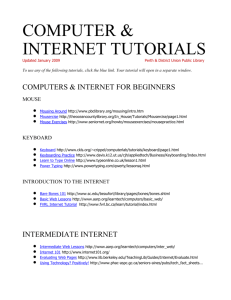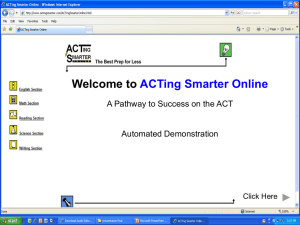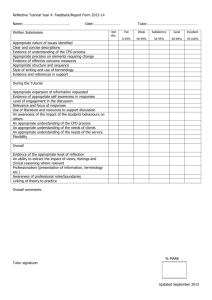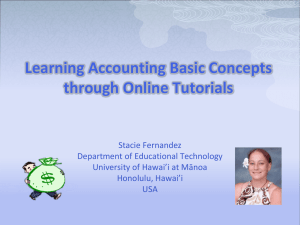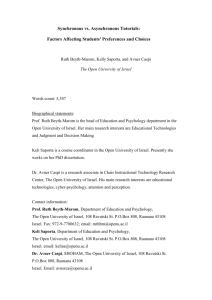Further reading - University of Adelaide
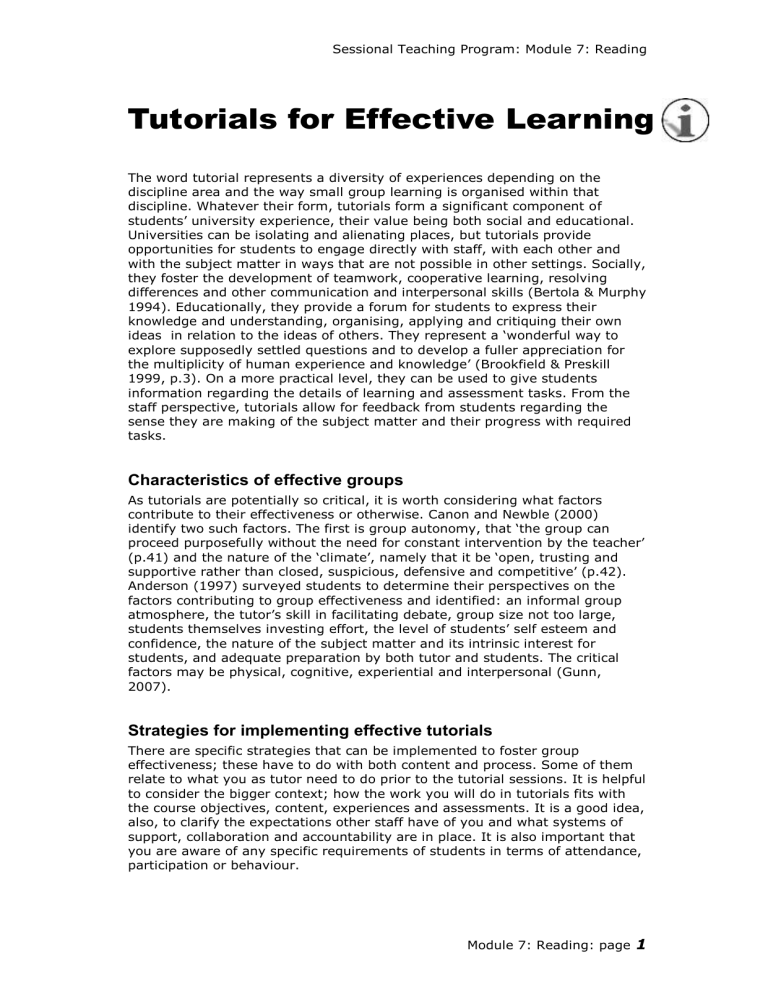
Sessional Teaching Program: Module 7: Reading
Tutorials for Effective Learning
The word tutorial represents a diversity of experiences depending on the discipline area and the way small group learning is organised within that discipline. Whatever their form, tutorials form a significant component of students’ university experience, their value being both social and educational.
Universities can be isolating and alienating places, but tutorials provide opportunities for students to engage directly with staff, with each other and with the subject matter in ways that are not possible in other settings. Socially, they foster the development of teamwork, cooperative learning, resolving differences and other communication and interpersonal skills (Bertola & Murphy
1994). Educationally, they provide a forum for students to express their knowledge and understanding, organising, applying and critiquing their own ideas in relation to the ideas of others. They represent a ‘wonderful way to explore supposedly settled questions and to develop a fuller appreciation for the multiplicity of human experience and knowledge’ (Brookfield & Preskill
1999, p.3). On a more practical level, they can be used to give students information regarding the details of learning and assessment tasks. From the staff perspective, tutorials allow for feedback from students regarding the sense they are making of the subject matter and their progress with required tasks.
Characteristics of effective groups
As tutorials are potentially so critical, it is worth considering what factors contribute to their effectiveness or otherwise. Canon and Newble (2000) identify two such factors. The first is group autonomy, that ‘the group can proceed purposefully without the need for constant intervention by the teacher’
(p.41) and the nature of the ‘climate’, namely that it be ‘open, trusting and supportive rather than closed, suspicious, defensive and competitive’ (p.42).
Anderson (1997) surveyed students to determine their perspectives on the factors contributing to group effectiveness and identified: an informal group atmosphere, the tutor’s skill in facilitating debate, group size not too large, students themselves investing effort, the level of students’ self esteem and confidence, the nature of the subject matter and its intrinsic interest for students, and adequate preparation by both tutor and students. The critical factors may be physical, cognitive, experiential and interpersonal (Gunn,
2007).
Strategies for implementing effective tutorials
There are specific strategies that can be implemented to foster group effectiveness; these have to do with both content and process. Some of them relate to what you as tutor need to do prior to the tutorial sessions. It is helpful to consider the bigger context; how the work you will do in tutorials fits with the course objectives, content, experiences and assessments. It is a good idea, also, to clarify the expectations other staff have of you and what systems of support, collaboration and accountability are in place. It is also important that you are aware of any specific requirements of students in terms of attendance, participation or behaviour.
Module 7: Reading: page 1
Sessional Teaching Program: Module 7: Reading
For any particular session, preparation is important; plan and structure the time available for the tutorial – what will you do during the session and when you will do it. It is important to ascertain the students’ initial knowledge and understanding of the topic in order to pitch the session at an appropriate level.
It is also important to be very specific about the objectives of the session – what it is the students are to get out of it – and just how you anticipate that will happen.
The first session with a group is particularly important as it establishes the climate for how the group will function in subsequent sessions. Some tutors find it useful to spend some time in that initial session formulating ground rules for the group. These can then be referred to if issues arise in later sessions.
Having the students reflect on their experiences of effective and ineffective groups can be a way of stimulating ideas as to what might be important to include in the group’s rules. As the group climate is of critical importance, it is also valuable to spend some initial time on establishing the group as a group through some sort of ice-breaker, inviting the students to share some information about themselves which may or may not be related to the subject under study.
There are a whole range of strategies by which you can endeavour to engage students with the subject matter and with each other. It is good to build up your own repertoire to select from according to the mix of students in any particular group, to the topic and task to be undertaken and to your own personal style and inclination. Brookfield and Preskill (1999) have devised a wide-ranging collection detailing ways of engaging students in small groups.
Some of these are set out below, intermixed with similar ideas from Bertola and Murphy (1994), Race (n.d.), Anderson (1997), Cannon and Newble (2000) and Gunn (2007). For example, if the students are struggling with a topic, one strategy is to focus on critical points in their struggle. What was the moment of greatest confusion or frustration; when did they feel most connected; when most distanced?
Rather than simply asking students to identify the key points within a reading, students could be presented with a scenario such as If the author were to
attend our next tutorial, what question would you like to ask them? They could be given the task of selecting one or more quotable quotes from the reading or of identifying some concrete image that appealed to them or which they found challenging. They could be encouraged to engage more critically by uncovering any assumptions or biases in the text. You could ask them to conjecture as to why someone might espouse the viewpoints of the author or what grounds would support such views.
There are strategies you can use to draw students into active participation and to try to even out that participation, diminishing any tendencies towards domination or passivity. One simple technique is to have students respond individually in writing and then take turns telling of what they had written. The telling can be quite structured, for example each person in turn is given, say, three minutes contribution time and no-one can make an additional comment until the round has been completed. A strategy which encourages students to listen to each other is to have each speaker summarise the views of the preceding speaker before sharing their own ideas. Alternatively, one or more students can be given the role of summariser, their task being to keep track of and record the points made by others during the discussion.
There can be more than one assigned role in a group. Brookfield and Preskill
(1997), for example, suggest allocating roles of ‘story-teller’ who presents an
Module 7: Reading: page 2
Sessional Teaching Program: Module 7: Reading argument or set of ideas, ‘detectives’ who critique the presentation by watching for unacknowledged or unquestioned assumptions (essentially asking
who sez?) and an ‘umpire’ whose job is to ensure that the process is carried out in a respectful manner. To encourage students to take on an even greater range of roles in discussion, they also suggest randomly allocating group moves (such as ask a question or make a comment that shows you are
interested in what another person has said or make a comment that at least
partly paraphrases a point someone has already made) or group roles (such as
Problem, Dilemma or Theme Poser or Reflective Analyst) to students in the group.
When things go wrong
No matter how well prepared or how resourceful the strategies you have chosen, it is highly likely that, at times, things will not go as well as you’d hoped. One of the most common scenarios is that some students will dominate while others remain passive. Some of the strategies in the previous section can be drawn on here, with the judicious assigning of roles to those tending to either over- or under-participate. Speaking individually, outside of class time, with students taking on those more extreme roles can also be effective; acknowledging the enthusiasm of the more dominant and enlisting their support in trying to engage others, and asking the more passive members what might encourage their more active involvement.
If students come unprepared, it may be helpful to try to find out why.
Employing strategies, such as allowing reading or working time in class, may redress the lack of preparation. Having some kind of tangible reward, such as a mark allocation, for prepared work may provide some motivation. Shaming or sarcasm will almost certainly have negative outcomes and are best avoided.
Sometimes, students may seem unable rather than unwilling to complete an assigned task. A good starting point may be to establish just what they are able to manage and work out how that can be built on. Various students may have complementary understandings which can help each other. The incorporation of analogies, diagrams or real-life applications can also be productive strategies.
Tutors may be tempted, from desperation, from a desire to help, or in response to student pressure, to turn tutorials into mini-lectures. While this may fill uncomfortable silences and be a way of dealing with student reluctance, it is not very sound educational practice and negates the whole
‘active learning principles’ of tutorials, with students actively engaged in the learning process. It might be helpful to think of yourself as someone who facilitates students learning rather than the expert who is able to provide all the answers. In fact, modelling what you do when you don’t know something
(formulating hypotheses to test, working through alternative possibilities, seeking out appropriate resources) can provide valuable learning for students.
Evaluating tutorials
In order to continue a cycle of becoming a more effective tutor, it is necessary to evaluate the effectiveness of your tutorials. After each tutorial reflect on what worked and what didn’t and apply those insights in future sessions. You can also obtain student feedback, both formal and informal. Informally, you can observe their demeanour and behaviour, their level of participation and their level of energy and enthusiasm. You can also ask for more formal
Module 7: Reading: page 3
Sessional Teaching Program: Module 7: Reading feedback on specific strategies or sessions of on a series of tutorials. You could also ask another tutor or lecturer to sit in and observe a tutorial and give you feedback. You could negotiate with another tutor to give reciprocal feedback, perhaps asking for a focus on particular aspects.
Conclusion
Tutorials represent some of the most significant learning experiences students encounter at university. There they can engage with the subject matter, with you and with each other in ways that are not possible in other learning contexts. It is important that the tutorial climate is one in which students feel safe and respected, a place where they can have a go and try out ideas without fear of shame or ridicule. It is also important that they are stimulated to participate by the tasks and processes required of them. The tutor plays a vital role in all this and can make all the difference to a student’s experience of university.
References
Anderson, C (1997) Enabling and shaping understanding through tutorials. In F
Marton, N Entwistle & D Hounsell The Experience of Learning:
Implications for Teaching and Studying in Higher Education, Scottish
Academic Press, Edinburgh. Available at
< http://www.tla.ed.ac.uk/resources/ExperienceOfLearning/EoL12.pdf
>.
University Library 378.170281 M387e
Bertola, P & Murphy, E (1994) Tutoring at university: a beginner’s practical
guide, Paradigm Books, Bentley.
Brookfield S & Preskill, S (1999) Discussion as a way of teaching: tools and
techniques for university teachers, SRHE & Open University Press,
Buckingham.
Cannon, R & Newble, D (2000) A handbook for teachers in universities and
colleges: a guide to improving teaching methods, Kogan Page, London.
Gunn, V (2007) Approaches to small group learning and teaching, Learning and
Teaching Centre, University of Glasgow. Available at
< http://www.gla.ac.uk/media/media_12157_en.pdf
>.
Race, P (n.d.) In at the deep end – starting to teach in higher education, Leeds
Metropolitan University, Leeds. Available at
< https://www.adelaide.edu.au/clpd/teaching/resources/restricted/inAtTh eDeepEnd.pdf
> (Uni of Adelaide staff access only).
Module 7: Reading: page 4
Sessional Teaching Program: Module 7: Reading
Further reading
Centre for Learning and Teaching Assessment, University of Edinburgh 2003,
Reviewing your teaching. Available at
< http://www.tla.ed.ac.uk/resources/ryt/index.htm
>.
Kerry O'Regan, June 2007
© The University of Adelaide
Module 7: Reading: page 5

